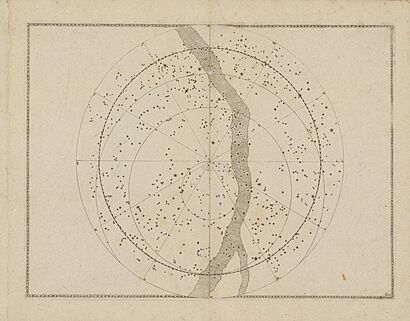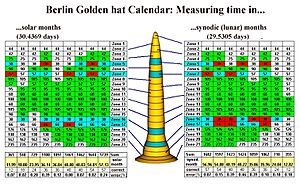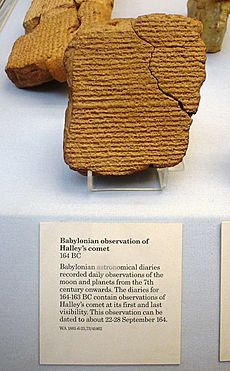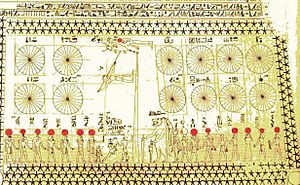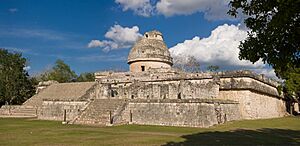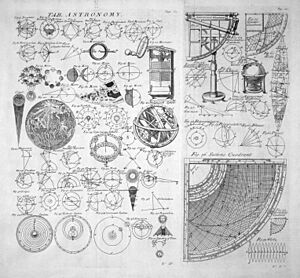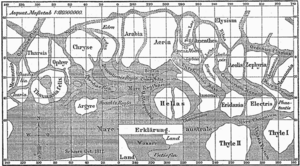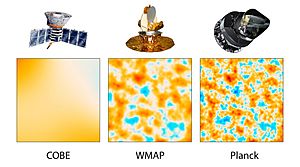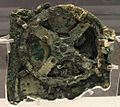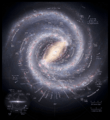History of astronomy facts for kids
The history of astronomy is all about how people have learned more about the universe over time. Astronomy is the study of everything beyond Earth's atmosphere, like stars, planets, and galaxies. It's one of the oldest natural sciences, meaning it studies the natural world.
People started studying the sky a very long time ago. They used astronomy for many things, like keeping track of time, finding their way when traveling, and even for religious reasons. Ancient astronomers watched the sky carefully to understand how the universe works. During the Renaissance (a time of great change in Europe), new ideas about astronomy appeared. For example, in 1593, Nicolaus Copernicus suggested that the planets orbit the Sun, not the Earth. This idea started the "Copernican Revolution."
Astronomy became successful early on because it used mathematics. It also used special tools like armillary spheres to collect and check data. Over the years, astronomy has grown into many different areas. These include astrophysics (the physics of space), observational astronomy (watching the sky), theoretical astronomy (using math to predict things), and astrobiology (the study of life in space).
Contents
Early Discoveries in Astronomy
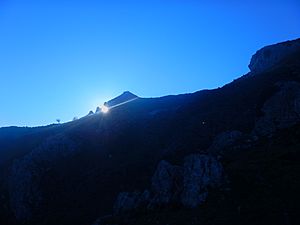
Long ago, people thought that objects in the sky were gods or spirits. They believed that the movements of these objects caused things like rain, drought, and different seasons. Many early astronomers were priests. They thought that events in the sky were messages from the gods. This is why early astronomy was often linked to what we now call astrology.
Some very old carvings might be the first star maps. A 32,500-year-old carved ivory tusk might show the constellation Orion. Drawings in the Lascaux caves in France, from 33,000 to 10,000 years ago, might show star groups like the Pleiades. Ancient structures like Stonehenge also seem to line up with the Sun or Moon. These places probably had religious and social uses, too.
People used observations of the Sun and Moon to create calendars. These calendars helped them track days, months, and years. This was very important for farming societies. Farmers needed to know the right time to plant crops. A nearly full moon also provided light for traveling at night.
Our modern calendar, the Gregorian calendar, is based on the old Roman calendar. The Roman calendar originally followed the Moon's phases. But it later changed to have twelve months, mostly with 30 or 31 days. Julius Caesar updated the calendar in 46 BC. He introduced the Julian calendar, which used a year length of 365 and a quarter days. This idea came from the Greek astronomer Callippus in the 4th century BC.
Ancient European Astronomy
Ancient objects found across Europe show that people in the Stone Age and Bronze Age knew a lot about mathematics and astronomy.
Here are some cool discoveries:
- Some bone sticks from 35,000 BC might have marks that track the Moon's phases. This idea was suggested by archaeologist Alexander Marshack.
- The Warren Field calendar in Scotland is the oldest known calendar. It was made around 8000 BC. This calendar has 12 pits that seem to track lunar months. It also lines up with the sunrise at the winter solstice. This helped people match the solar year with the Moon's cycles. People kept this calendar working for 6,000 years!
- The Goseck circle in Germany was found in 1991. It's one of many circular enclosures built around 5000 BC. These sites were likely used for astronomical observations.
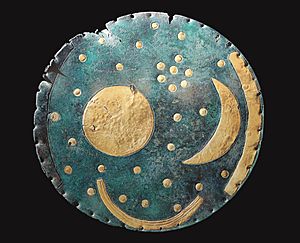
- The Nebra sky disk is a bronze disk from the Bronze Age. It was buried in Germany around 1600 BC. It has gold symbols showing a full moon, a crescent moon, and the Pleiades star cluster. This is the oldest known picture of objects in the sky. It helped people figure out when to add an extra month to their calendar. This kept their lunar calendar in sync with the solar year.
- The Kokino site in North Macedonia was found in 2001. It was an astronomical observatory built around 1900 BC. It helped people observe the rising Sun and full moon. It had markings for the summer and winter solstices and the equinoxes. It also helped track the Moon's movements.
- Golden hats from Germany, France, and Switzerland date from 1400 to 800 BC. These hats are decorated with spirals of the Sun and Moon. They were probably a type of calendar. They helped people match the lunar calendar with the solar calendar.
Ancient Civilizations and the Stars
Mesopotamia: Land of Early Astronomers
Astronomy began in Mesopotamia, a region between the Tigris and Euphrates rivers. This is where ancient kingdoms like Sumer, Assyria, and Babylonia were located. The Sumerians developed a writing system called cuneiform around 3500–3000 BC. We know about Sumerian astronomy from Babylonian star catalogs from about 1200 BC. Many star names are Sumerian, showing a long history of sky-watching.
The Sumerians also used a base-60 number system. This made it easier to record very large or very small numbers. This is why we divide a circle into 360 degrees and an hour into 60 minutes.
The first known astronomer and poet by name was Enheduanna. She was an Akkadian high priestess around 2334–2279 BCE. She tracked the Moon from her rooms and wrote poems about it.
The Babylonians were the first to realize that astronomical events happen in cycles. They also used mathematics to predict these events. Tablets from the Old Babylonian period show how they used math to track the changing length of daylight. The Enūma Anu Enlil is a series of cuneiform tablets that record centuries of Babylonian observations. One important tablet, the Venus tablet of Ammisaduqa, lists when Venus appeared and disappeared over 21 years. This is the earliest proof that planet movements were known to be periodic.
Babylonian astronomy was very important. It influenced much of what was done in Greek astronomy, Indian astronomy, and later Islamic astronomy.
India: Calendars and Comets
Astronomy in India goes back to the Indus Valley Civilisation around 3000 BC. It was used to create calendars. The oldest Indian astronomy text is the Vedanga Jyotisha, from the Vedic period (around 1350 BC). It describes rules for tracking the Sun and Moon for religious rituals.
Aryabhata (476–550 AD) wrote a major work called Aryabhatiya. In it, he suggested a system where the Earth spins on its axis. He also calculated many astronomical numbers accurately. These included the periods of planets and the times of solar and lunar eclipses.
During the Shunga Empire, many star catalogues were made. This time is called the "Golden age of astronomy in India." Astronomers calculated the movements of planets, their rising and setting, and when they would join together in the sky. They also calculated eclipses.
By the 6th century, Indian astronomers believed that comets were celestial bodies that returned regularly. Astronomers like Varahamihira and Bhadrabahu held this view.
Greece: Models of the Cosmos
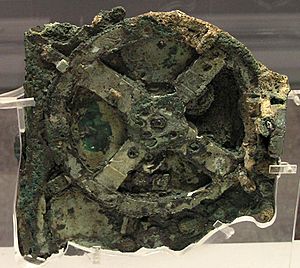
The Ancient Greeks developed astronomy to a very advanced level. They saw it as a part of mathematics. In the 4th century BC, Eudoxus of Cnidus and Callippus of Cyzicus created the first 3D models to explain how planets seemed to move. Their models used nested spheres centered on the Earth. A younger astronomer, Heraclides Ponticus, suggested that the Earth rotates on its axis.
Philosophers like Plato and Aristotle also thought about the sky. They wanted to explain why things moved in the cosmos. Plato described the universe as a sphere with circles carrying the planets. Aristotle suggested a complex system of concentric spheres. These spheres moved in circles, carrying the planets around the Earth. This idea was popular until the 16th century.
In the 3rd century BC, Aristarchus of Samos was the first to suggest a heliocentric system. This means he thought the Earth and planets orbited the Sun. Eratosthenes also accurately estimated the circumference of the Earth.
Greek astronomers later used more complex models. These models involved circles moving on other circles to explain planet movements. Apollonius of Perga and Hipparchus of Nicea developed these ideas. Hipparchus also measured precession (a slow wobble of Earth's axis). He also created the first star catalog and our modern system of apparent magnitudes (how bright stars appear).
The Antikythera mechanism is an amazing ancient Greek device. It was an early astronomical computer from about 150–100 BC. It could calculate the movements of the Sun, Moon, and possibly planets. It was found in an ancient shipwreck. This device was very advanced for its time.
Ptolemy's Earth-Centered System
Ptolemy, a Greco-Roman astronomer from Egypt, wrote a very important book called Almagest. This book presented a complete picture of geocentric astronomy, meaning an Earth-centered universe. His ideas greatly influenced astronomy until the Renaissance. Ptolemy also created a physical model of his system, imagining a universe much smaller than what Aristarchus of Samos had thought.
Ancient Egypt: Sky and Religion
The precise way the Egyptian pyramids are built shows how skilled ancient Egyptians were at watching the sky. The pyramids were lined up with the pole star. At that time, the pole star was Thuban, a faint star in the constellation Draco. The Great Temple at Karnak was also aligned with the rising of the midwinter Sun.
Astronomy was very important for Egyptian religious practices. It helped them set dates for festivals and tell time at night. The rising of Sirius (the "dog star") was especially important. When Sirius rose in the east before sunrise, it meant the Nile River would soon flood. This event was crucial for their farming.
Ancient texts describe how Egyptian astrologers used tools to observe the stars. They used a plumb line and a sighting instrument. These tools helped them determine the north axis when building temples. This shows how accurate their observations could be.
China: Detailed Records and Supernovae
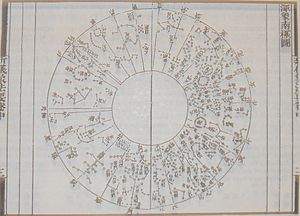
Astronomy in East Asia began in China. Chinese astronomers kept detailed records of their observations from about the 6th century BC. They could accurately predict eclipses.
Much of early Chinese astronomy was for timekeeping. They used a lunisolar calendar, which combines Sun and Moon cycles. Astronomers often created new calendars and made observations for this purpose.
Chinese astronomers also paid close attention to "guest stars." These were stars that suddenly appeared among the fixed stars. They were the first to record a supernova in 185 AD. The supernova that created the Crab Nebula in 1054 was also observed by Chinese astronomers. Ancient records of events like supernovae and comets are still used by modern astronomers today.
The world's first star catalogue was made by Gan De, a Chinese astronomer, in the 4th century BC.
Mesoamerica: Maya Sky-Watchers
The Maya people had very detailed astronomical records. Their books, called Maya codices, included tables for calculating Moon phases and eclipses. They also tracked the appearance of Venus as the morning and evening star. The Maya based their calendars on the cycles of the Pleiades, the Sun, Moon, Venus, and other planets. The Milky Way galaxy was also very important in their beliefs.
Many important Maya buildings are thought to have been built facing the extreme rising and setting points of Venus. The ancient Maya believed Venus was linked to war. Many battles were planned based on its movements.
The Maya believed that Earth was the center of everything. They thought the stars, moons, and planets were gods. They believed these gods traveled between Earth and other places in the sky. Many important events in Maya culture were timed around celestial events. They thought certain gods would be present then.
Astronomy in the Middle Ages
Middle East: Observatories and New Tools
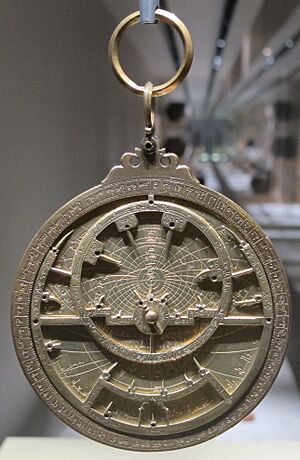
During the Middle Ages, the Arabic and Persian world under Islam became very advanced. Many important works from Greek, Indian, and Persian astronomy were translated into Arabic. These texts were kept in libraries across the region. Islamic astronomers focused on observational astronomy, meaning they built tools and watched the sky carefully. This led to the creation of the first astronomical observatories in the Muslim world by the early 9th century. They created star catalogs called Zij.
In the 9th century, the Persian astrologer Albumasar was very influential. His guides for astrologers affected Muslim thinkers and later, European scholars. Abd al-Rahman al-Sufi (Azophi) observed stars and described their positions, brightness, and colour. He also drew pictures for each constellation in his Book of Fixed Stars. He gave the first descriptions of the Andromeda Galaxy and the Large Magellanic Cloud.
In 1006, Ali ibn Ridwan observed SN 1006, the brightest supernova ever recorded. He wrote a detailed description of this temporary star.
In the late 10th century, a huge observatory was built near Tehran, Iran. The astronomer Abu-Mahmud al-Khujandi used it to measure the Sun's position. This helped him calculate the tilt of the Earth's axis. He noticed that earlier measurements showed a greater tilt. This might mean the Earth's tilt is slowly changing. In the 11th century, Omar Khayyám in Persia created a calendar that was more accurate than the Julian Calendar. It was very close to our modern Gregorian calendar.
Muslim astronomers also collected and corrected old astronomical data. They solved problems in the Ptolemaic model. They invented new tools like the universal astrolabe. They also believed that heavenly bodies followed the same physical laws as Earth.
India: Advanced Calculations
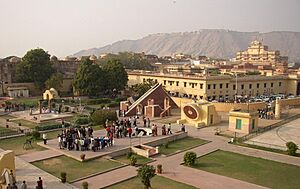
Bhāskara II (1114–1185) was in charge of the astronomical observatory at Ujjain. He continued the mathematical work of Brahmagupta. He wrote Siddhantasiromani, which had parts on spheres and planet mathematics. He also calculated the time it takes for the Sun to orbit the Earth with great accuracy. The Buddhist University of Nalanda also offered astronomy courses.
Other important Indian astronomers included Madhava of Sangamagrama and Nilakantha Somayaji. They were part of the Kerala school of astronomy and mathematics from the 14th to 16th centuries. Nilakantha Somayaji developed his own system where Mercury, Venus, Mars, Jupiter, and Saturn orbit the Sun, and the Sun then orbits the Earth. This was similar to the Tychonic system proposed later by Tycho Brahe.
Western Europe: Reawakening of Knowledge
After the great contributions of Greek scholars, astronomy in Western Europe slowed down. This lasted from the Roman era until the 12th century. Many advanced Greek astronomy texts were lost or not understood. Only simpler summaries were available.
In the 6th century, Bishop Gregory of Tours used basic astronomy to help monks tell time at night by watching the stars. In the 7th century, the English monk Bede of Jarrow wrote an important text called On the Reckoning of Time. It helped churchmen calculate the correct date for Easter. This text was used for centuries.
During the Carolingian Renaissance, people started to study astronomy again. By the 9th century, simple ways to calculate planet positions were known. Scholars knew these methods had flaws, but they kept copying the texts. This showed their interest in planet movements and their astrological meaning.
In the 10th century, European scholars like Gerbert of Aurillac traveled to Spain and Sicily. They wanted to find knowledge from the Arabic-speaking world. There, they learned about practical astronomy, like using the astrolabe. Soon, scholars like Hermann of Reichenau were writing about how to use and build astrolabes. Others used astrolabes to observe eclipses and check their calculations.
By the 12th century, more advanced astronomy texts were translated into Latin from Arabic and Greek. These new texts came as universities were rising in medieval Europe. They quickly became part of university studies. John of Sacrobosco wrote popular astronomy textbooks.
In the 14th century, Nicole Oresme showed that arguments against Earth's movement were not strong. He even suggested that the Earth moves, not the heavens. However, he concluded that most people, including himself, believed the heavens moved and not the Earth. In the 15th century, Cardinal Nicholas of Cusa suggested that the Earth revolved around the Sun. He also thought that each star was a distant sun.
The Copernican Revolution and Beyond
A New View of the Universe
During the Renaissance, astronomy went through a huge change called the Copernican Revolution. This started with Nicolaus Copernicus, who proposed a heliocentric system. In this system, the planets orbit the Sun, not the Earth. His book, De revolutionibus orbium coelestium, was published in 1543. At first, this idea caused only minor debate. But it became the main view because people like Galileo Galilei, Johannes Kepler, and Isaac Newton supported and improved it.
Tycho Brahe, a Danish noble, was a key astronomer of this time. He showed that a supernova (a new bright star) in 1572 disproved the old idea that the heavens never changed. He also created the Tychonic system. In this system, the Sun, Moon, and stars orbit the Earth, but the other five planets orbit the Sun. This system combined ideas from Copernicus and Ptolemy. Brahe was famous for his very accurate observations of stars and planets. His assistant, Johannes Kepler, later used these observations.
After Brahe died, Kepler continued his work. Kepler was the first to try to explain planet movements using physical causes. He discovered the three Kepler's laws of planetary motion:
- Planets orbit the Sun in an ellipse (an oval shape), with the Sun at one focus.
- A line from a planet to the Sun sweeps out equal areas in equal times. This means planets move faster when closer to the Sun.
- The square of a planet's orbital period (time to go around the Sun) is proportional to the cube of its average distance from the Sun.
These laws greatly improved the heliocentric model. Kepler realized that orbits were ellipses, not perfect circles. This made the Copernican model much more accurate.

Galileo Galilei was one of the first to use a telescope to look at the sky. In 1610, he discovered the four largest moons of Jupiter. These are now called the Galilean moons. This was the first time anyone saw satellites orbiting another planet. He also found that the Moon had craters and that the Sun had spots. He correctly explained that Venus showed phases, just like the Moon.
Galileo argued that these discoveries did not fit the Ptolemaic (Earth-centered) model. For example, Jupiter's moons showed that not everything orbited Earth. The phases of Venus proved it orbited the Sun. The Ptolemaic system said heavenly bodies were perfect, so craters or sunspots shouldn't exist. Galileo faced challenges from church officials. They accused him of heresy because his ideas went against their teachings. He was eventually tried and found guilty in 1633. His book was banned, and he was put under house arrest until he died in 1642.
Sir Isaac Newton connected physics and astronomy with his law of universal gravitation. He realized that the same force that pulls objects to Earth also keeps the Moon in orbit. Newton explained all known gravitational events in one system. In his book, Philosophiæ Naturalis Principia Mathematica, he showed how Kepler's laws came from basic principles:
- An object stays at rest or moves at a constant speed unless a force acts on it.
- The force on an object equals its mass times its acceleration (F = ma).
- For every action, there is an equal and opposite reaction.
Kepler explained how planets moved, but Newton explained why they moved that way. Newton's ideas formed the basis of modern physics.
Exploring Our Solar System
Newton's theory took some time to be accepted outside of England. But eventually, it became the standard. Edmond Halley successfully predicted the return of the comet that bears his name in 1758. Sir William Herschel found the first new planet, Uranus, in 1781. The space between Mars and Jupiter was filled with the discovery of asteroids like Ceres in 1801. Many more asteroids followed.
Early astronomy in America was based on old ideas. But interest in the new astronomy grew. It started appearing in Almanacs as early as 1659.
Understanding the Stars
The idea that stars are distant suns, perhaps with their own planets, is called Cosmic pluralism. This idea was suggested in ancient times by Anaxagoras. But it wasn't widely accepted. The first Renaissance astronomer to suggest this was Giordano Bruno in 1584. This idea was one of the reasons he was charged by the Inquisition.
The idea became common in the late 17th century. This was especially after the book Conversations on the Plurality of Worlds was published in 1686. By the early 18th century, it was the normal working idea in stellar astronomy.
The Italian astronomer Geminiano Montanari observed changes in the brightness of the star Algol in 1667. Edmond Halley measured the movement of nearby "fixed" stars. He showed they had changed positions since the time of the ancient Greek astronomers. William Herschel was the first to try to map how stars are spread out in the sky. He counted stars in many directions. He found that the number of stars increased towards the Milky Way core. His son, John Herschel, did the same in the southern hemisphere. William Herschel also discovered that some stars are physical companions, forming binary star systems.
Modern Astronomy: New Tools, New Discoveries
19th Century: Photography and Invisible Light
Before photography, astronomers had to record data with their eyes. In 1840, John W. Draper took the first known astronomical photograph of the Moon. By the late 19th century, thousands of photos of planets, stars, and galaxies were taken. Photography could capture more light over longer times than the human eye. This greatly increased the amount of data for astronomers. This led to the rise of "human computers" (people who did calculations), like the famous Harvard Computers. They tracked and analyzed the data.
Scientists also discovered forms of light that we can't see. These include X-rays, gamma rays, radio waves, and ultraviolet radiation. This had a huge impact on astronomy. It led to new fields like infrared astronomy and radio astronomy. With spectroscopy (studying light by splitting it into colors), scientists proved that other stars are like our Sun. But they have different temperatures, masses, and sizes.
The science of stellar spectroscopy was started by Joseph von Fraunhofer and Angelo Secchi. They compared the light from stars like Sirius to the Sun. They found differences in their absorption lines (dark lines in the light caused by gases). In 1865, Secchi began classifying stars by their spectral types. The first evidence of helium was seen in the Sun's spectrum in 1868.
The first direct measurement of the distance to a star (61 Cygni) was made in 1838 by Friedrich Bessel. He used the parallax technique. Parallax measurements showed how incredibly far apart stars are. Observing double stars also became important. In 1834, Friedrich Bessel saw changes in the movement of Sirius. He guessed it had a hidden companion. Edward Charles Pickering discovered the first spectroscopic binary in 1899. He saw the light lines of the star Mizar splitting regularly. This showed it was two stars orbiting each other. By studying many binary star systems, astronomers could figure out the masses of stars. In 1847, Maria Mitchell discovered a comet using a telescope.
20th Century: Galaxies, Expansion, and Space Telescopes

In the 20th century, large amounts of astronomical data were collected. This led to teams like the Harvard Computers becoming important. Many female astronomers, who were often assistants, gained recognition. Henrietta Swan Leavitt discovered the relationship between the brightness and pulsation period of cepheid variable stars. This became a way to measure distances outside our Solar System.
Annie Jump Cannon, a Harvard Computer, developed the modern system for classifying stars in the early 1900s. She classified more stars in her lifetime than anyone else (around 350,000).
The 20th century saw very fast progress in studying stars. Karl Schwarzschild found that a star's color and temperature could be determined by comparing its visual and photographic brightness. The photoelectric photometer allowed for very precise brightness measurements. In 1921, Albert A. Michelson made the first measurements of a star's diameter using an interferometer.
Important ideas about the physical structure of stars came out in the early 20th century. In 1913, the Hertzsprung–Russell diagram was developed. This diagram plots a star's brightness against its temperature. It helped astrophysicists study stars. Cecilia Payne-Gaposchkin first suggested in 1925 that stars are mostly made of hydrogen and helium. Advances in quantum physics helped astronomers understand star spectra even better. This allowed them to figure out what elements were in a star's atmosphere.
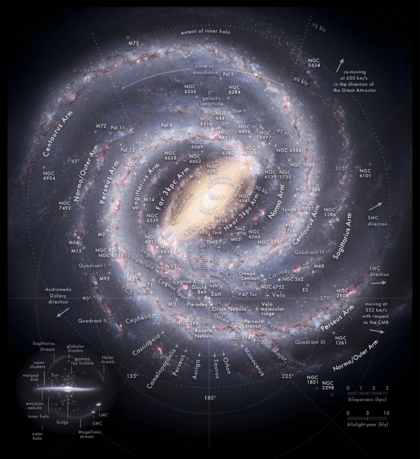
The existence of our galaxy, the Milky Way, as a separate group of stars was only proven in the 20th century. We also learned about other "external" galaxies. Soon after, we discovered that the universe is expanding. Most galaxies are moving away from us. The "Great Debate" in the 1920s was about the nature of the Milky Way and other spiral nebulae.
With quantum physics, spectroscopy became even more powerful. We found that the Sun is part of a galaxy with more than 10 billion stars. Edwin Hubble proved that the Andromeda nebula was a separate galaxy. He also found many other galaxies far away and moving away from us.
Physical cosmology, which studies the universe as a whole, made huge progress in the 20th century. The Big Bang model, which says the universe started from a hot, dense state, is strongly supported by evidence from astronomy and physics. This evidence includes the redshift of distant galaxies, the cosmic microwave background radiation, and Hubble's law.
Images for kids
-
This picture shows a sunset during an equinox (when day and night are equal length) at an ancient site in Sicily.
-
The Nebra sky disk from Germany, made around 1800–1600 BC. It shows the Moon, Sun, and stars.
-
This ancient Babylonian tablet, now in the British Museum, records Halley's Comet in 164 BC.
-
The Antikythera Mechanism was an ancient Greek analog computer. It was built around 150 to 100 BC to calculate the positions of astronomical objects.
-
This printed star map was made by Su Song (1020–1101) in China. It shows the south polar projection.
-
The "El Caracol" observatory temple at Chichen Itza, Mexico.
-
An Arabic astrolabe from 1079 to 1080 AD. Astrolabes were used to measure the positions of stars and planets.
-
The historical Jantar Mantar observatory in Jaipur, India.
-
Galileo Galilei (1564–1642) used his own telescope to make amazing discoveries. He found craters on the Moon, moons around Jupiter, spots on the Sun, and phases of Venus.
-
This map of Mars was made by Giovanni Schiaparelli in 1888.
-
The Hubble Space Telescope has taken amazing pictures of the universe.
-
This map shows our Milky Way Galaxy. It labels the main arms, central bulge, and other features.
See also
 In Spanish: Historia de la astronomía para niños
In Spanish: Historia de la astronomía para niños
- Age of the universe
- Anthropic principle
- Astrotheology
- Expansion of the universe
- Hebrew astronomy
- History of astrology
- History of Mars observation
- History of supernova observation
- History of the telescope
- Letters on Sunspots
- List of astronomers
- List of French astronomers
- List of Hungarian astronomers
- List of Russian astronomers and astrophysicists
- List of Slovenian astronomers
- List of women astronomers
- List of astronomical instrument makers
- List of astronomical observatories
- Patronage in astronomy
- Society for the History of Astronomy
- Timeline of astronomy
- Timeline of Solar System astronomy
- Worship of heavenly bodies



